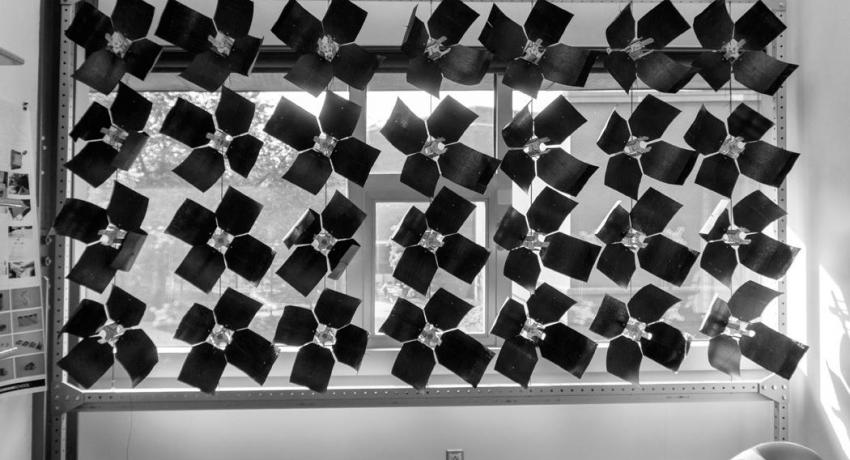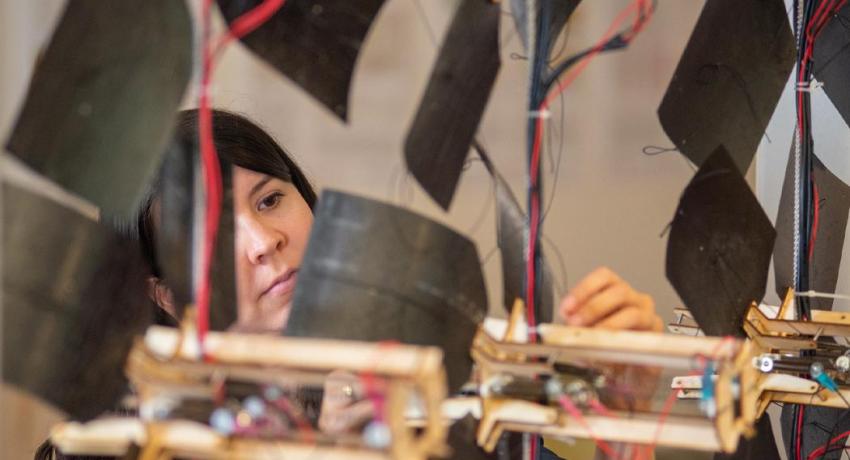The responsive building façade system features screens made of smart and bistable materials that are located inside a building’s windows that open and close based on the weather conditions and lighting outside, as well as the indoor lighting and climate requirements. Credit: Elena Vazquez.
By Pamela Krewson Wertz
UNIVERSITY PARK, Pa. — A Penn State-designed window screen system that automatically changes its shape based on indoor and outdoor environmental conditions is part of the Lisbon Architecture Triennale 2022 in Lisbon, Portugal through Dec. 5. The responsive building façade system features screens made of smart and bistable materials that are located inside a building’s windows that open and close based on the weather conditions and lighting outside, as well as the indoor lighting and climate requirements.
Faculty and student researchers from the Stuckeman Center for Design Computing in the College of Arts and Architecture, the Convergence Center for Living Multifunctional Systems in the College of Engineering and the Materials Research Institute collaborated to design the adaptive architecture project, which lets in or blocks sunlight to regulate the internal building temperature while consuming less energy.
The kinetic materials used by the team in the screens have not yet been used in building shading design.
Titled “Kinetic snapping skins: Envisioning climate-adaptive environments,” the project also uses artificial intelligence to predict environmental conditions and determine the best configuration of the façade for each time and day of the year.
Since buildings in the United States account for around 40% of total energy consumption, adaptive buildings can better satisfy the needs of those who use the buildings while also consuming less energy and material resources.
“This means that these buildings have a lower ecological footprint and can mitigate the effects of climate change,” said José Pinto Duarte, Stuckeman Chair in Design Innovation in the Stuckeman School and director of the SCDC.
Skidmore, Owings & Merrill, an architecture, urban planning and engineering firm based in New York, also collaborated on the project, which evolved from research that was initiated in the SCDC on smart buildings and cities.
“There’s a great consciousness among engineers of all different types about the energy costs regarding buildings,” said Clive Randall, director of the MRI and professor of materials science and engineering. “There will be ways in which we will be making bricks differently, where we will be making the overall structure of buildings differently, and also the lighting and transience of thermal properties will all be very different in the future to really bring down that net cost of energy.”
Elena Vazquez, a lead SCDC researcher on the project who graduated with her doctorate in architecture in August, said the goal was to develop a kinetic bistable screen that can help regulate daylight in buildings.
“Adaptive architecture, in general, and this adaptive screen project, in particular, are great demonstrators of living materials, which respond to external stimuli like sunlight or electricity to tilt, move and bend in order to protect the inside of the building from the outside,” said Zoubeida Ounaies, professor of mechanical engineering and director of the LiMC2.
According to Duarte, systems like the one the Penn State team designed can be incorporated in future buildings.
“This is just the beginning. Developments in sensing technology and the capacity of the system to learn will improve a building’s ability to collect data and find optimized integrations on many different levels,” he said.
Vazquez said the next step of the project would be “to find a way to fully automate the system and to find ways to make the materials even smarter, or we use solar energy to power the system.”
“These are all the ideas that we have for the future direction of the project,” she said.
The theme for the 2022 Lisbon Triennale is Terra (Earth) and consists of four exhibitions, four books, three awards, three days of conference proceedings and a selection of independent projects. The Penn State project was selected to be a part of the online publication for the Universities Award, which compiles research projects that an international jury determined reflect the theme of Terra.
In addition to its selection to the Lisbon Triennale, the “Kinetic snapping skins” project was awarded the American Institute of Architects UpJohn grant and the Architectural Research Centers Consortium Award.


